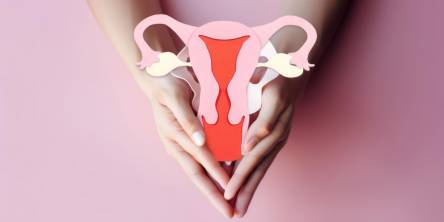Successful Treatment of Adenomyosis: Boon or a Bliss from Ayurveda

Successful Treatment of Adenomyosis: Boon or a Bliss from Ayurveda
Adenomyosis is a medical complication in the endothelial layers of the uterus which often leads to expansion of the uterus. This subsequently leads to heavy bleeding during menstruation with excessive pain or cramps in the lower abdomen. It occurs either in the entire uterus or specifically in a particular portion of the uterus which is generally considered to be a benign condition; however too much bleeding and pain may impose negative impact on the lives of the women to a large extent.
Major Factors Causing Adenomyosis:
First & foremost, adenomyosis can form from endometriosis due to the extension of endometrial tissue from outside the uterus. The extrinsic involvement of the uterus with adenomyosis defines the abnormal growth process from outside the uterus to inside. Some of the other theories that include the cause of adenomyosis are vaginal injury or breakage of tissues that allows inflammation & thereby leading to increased macrophages and cytokines to migrate in myometrium, causing the growth in tissue as typically seen in adenomyosis. Some believe it may cause due to some form of stimulation of migratory tissue in myometrium, due to high estrogen receptors. Other theories include the spread & formation of myometrium cells through stem cells or lymphatic system. Apart from this, there are many believed theories that causes adenomyosis, but until there isn’t sufficient research undertaken& adequate knowledge is gained; one can’t reach to a right conclusion on what exactly causes adenomyosis.
Typical Symptoms of Adenomyosis:
Women diagnosed with adenomyosis, typically suffer the following symptoms as mentioned below:
Bloating
Tenderness in the lower abdominal area.
Pelvic Pain
Blood clotsduring menstrual bleeding
Heavy bleeding during menstruation for a prolonged period of time.
Longer menstrual cycles than normal.
Severe & prolonged menstrual cramps in the lower abdomen.
Experiencing pain during intercourse.
Risk Factors for Adenomyosis:
There are some certain factors that women are prone to a greater risk for this condition & these include:
After childbirth
Before occurrence of menopause (for women in the age group of 40-50).
Post uterine surgery like cesarean delivery or a surgery to remove fibroids.
Diagnosis of Adenomyosis:
A complete medical examination can help to decide the best course of treatment. Doctor will physically examine initially to check if one’s uterus is swollen. Most of the women with adenomyosis have a uterus which is double the normal size. An ultrasound scan may be advised by the doctor to diagnose this condition; however at the same time to find the possibility of having tumour on the uterus.
Treatment:
Medical treatment is not advised to those women who are facing the mild forms of this condition; however it’s only recommended to those with severe symptoms that interfere their daily chores. Generally women suffering from adenomyosis are treated with
Hormonal Treatment
Anti-Inflammatory Medicines
Endometrial Ablation
Embolization of the Uterine Artery
Hysterectomy
Adenomyosis isn’t life threatening if treated in a right manner, there are various treatment procedures available to completely eradicate this condition. To get rid of this condition,the only way is to go through hysterectomy. This procedure involves the surgical removal of the uterus completely. It’s considered to be one of the major surgery & is only performed in severe cases in women who no longer plan to have children. The ovaries are thus not affected due to adenomyosis which are thus left safe in the body.
Last Words About Adenomyosis
By Research & experience — More important even than being schooled about adenomyosis — has been realizing how important it is for women to take charge of their own health care, to not be afraid to question and stand up to doctors. Even the more woke ones.
Similar Articles
When it comes to breast reconstruction, misinformation spreads faster than a Wi-Fi signal at a coffee shop.
Choosing the right tampon is important for both comfort and health. With more women seeking eco-friendly products free from harmful chemicals, organic tampons have become a popular option. In this article, you will learn the eight essential tips provided to help you make an informed choice when buying organic tampons in retail stores.
If you have hip discomfort during perimenopause or beyond menopause, there may be a relationship. Reduced estrogen levels might raise your chance of getting gluteal tendinopathy. They may also contribute to osteoarthritis, which can damage several joints, including the hips.
Of the estimated total population having osteoporosis and osteoarthritis, 80% are women. One in two women over the age of 50 get serious fractures because of onset or severe osteoporosis. A bone injury at that age means serious length of recovery and difficulty in returning to normal mobility.
Breast lift surgery lifts the breasts, strengthens the tissue, and eliminates extra skin to boost elevation and better nipple positioning.
An enlarged vagina can occur as a result of unrelated events, such as the end of pregnancy or after sex. It can also be caused by vaginal irritation from wearing synthetic fabric underwear or a sexually transmitted disease such as genital herpes.
Uterine fibroids are one of the most common gynecological diseases that affect many women during their reproductive years. In this article, we will look at all aspects of this condition, including its causes, symptoms, diagnosis, treatment, and possible complications.
Polycystic ovarian disease (PCOD) is a hormonal disorder prevalent among women of reproductive age. It occurs when a woman's ovaries or adrenal glands produce higher-than-normal levels of male hormones, called androgens. This hormonal imbalance disrupts the menstrual cycle and leads to the formation of small cysts on the ovaries
Uterine fibroids are benign tumors that develop in the uterine muscle tissue. According to the US Office on Women's Health (OWH), fibroids can grow as a single tumor or as a cluster in the uterus, and they can be as small as an apple seed or as large as a grapefruit.









